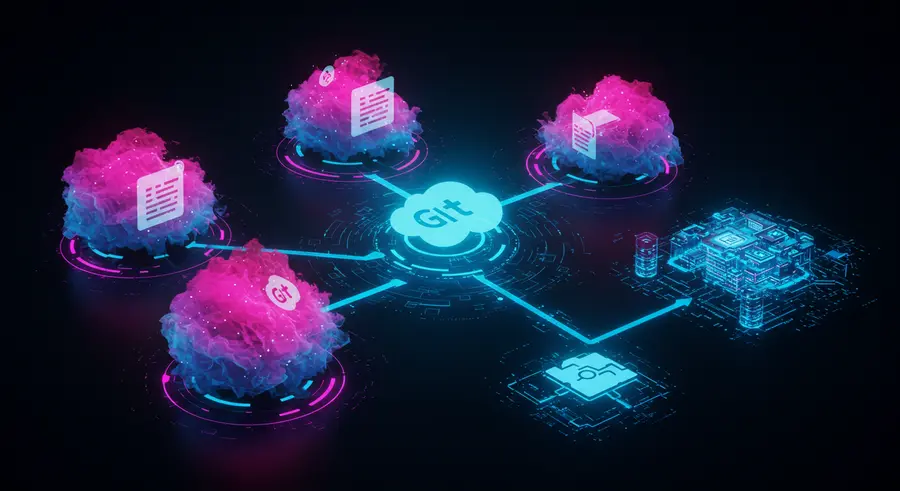Appearance

Welcome, tech enthusiasts! 👋 Today, we're embarking on a fascinating journey into the world of GitOps. If you're involved in modern software development and operations, you've likely heard this term circulating. But what exactly is GitOps, and why has it become a cornerstone of efficient, reliable, and secure infrastructure management? Let's break it down, explore its core principles, and understand how it's revolutionizing the way we deploy and manage applications.
What is GitOps? 🤔
At its heart, GitOps is an operational framework that takes DevOps best practices and applies them to infrastructure automation. It leverages Git as the single source of truth for declarative infrastructure and applications. Think of it as Infrastructure as Code (IaC), but with an added layer of automation and a strong emphasis on Git for version control, collaboration, and continuous delivery.
Instead of manually configuring servers or relying on imperative scripts, GitOps ensures that your entire system's desired state—from application configurations to infrastructure settings—is described in Git. Any change to your environment is a Git commit, and every deployment is a result of a Git pull. This approach brings the rigor of software development practices to operations.
The Four Core Principles of GitOps 🌟
GitOps isn't just a buzzword; it's built upon a set of fundamental principles that drive its effectiveness:
- Declarative Configuration: The desired state of your entire system (applications, infrastructure, configurations) is declared in a Git repository. This means you describe what you want your system to look like, not how to achieve it. Kubernetes, with its declarative APIs, is a perfect fit for this principle.
- Git as the Single Source of Truth: All changes to the desired state are committed and version-controlled in Git. This provides a complete audit trail, easy rollback capabilities, and a clear history of every modification. For a deeper understanding of Git and version control, check out our article on Understanding Git and Version Control.
- Automated Delivery: Changes in the Git repository are automatically applied to the target environment. This is typically achieved through continuous delivery pipelines that detect changes in Git and reconcile the live state with the desired state.
- Continuously Reconciled: An automated agent (often a Kubernetes Operator) continuously observes the actual state of the system and compares it to the desired state in Git. If any deviation is detected, the agent automatically takes action to bring the system back to its desired state. This self-healing capability is crucial for maintaining system stability.
How Does GitOps Work? The Workflow Explained 🛠️
The GitOps workflow typically follows a clear, auditable path:
- Developer Commits Changes: A developer or operations engineer makes changes to the application code or infrastructure configuration.
- Pull Request (PR) & Review: The changes are pushed to a Git repository, and a Pull Request (or Merge Request) is opened. These changes undergo code review, just like application code, ensuring quality and adherence to standards.
- Merge to Main: Once reviewed and approved, the PR is merged into the main branch (or a designated environment branch) of the Git repository.
- Automated Sync/Deployment: A GitOps operator (like Argo CD or Flux CD for Kubernetes) continuously monitors the Git repository. Upon detecting a new commit, it pulls the changes and applies them to the target environment, ensuring the live state matches the desired state in Git.
- Continuous Reconciliation: The operator then continuously monitors the environment, ensuring that it remains in sync with the Git repository. If any drift occurs (e.g., manual changes), the operator detects it and reverts the environment to the Git-defined state, or alerts for human intervention.
This pull-based deployment model, where the environment pulls changes from Git, is a hallmark of GitOps and provides enhanced security and reliability compared to traditional push-based CI/CD.
Benefits of Adopting GitOps 💪
Implementing GitOps brings a multitude of advantages to your development and operations teams:
- Increased Speed and Agility: Automating deployments and infrastructure changes accelerates the delivery process, allowing for faster iterations and quicker time-to-market.
- Improved Security: Git provides an immutable, auditable trail of all changes, making it easy to track who changed what and when. This enhances security and compliance.
- Enhanced Reliability: The continuous reconciliation process ensures that your infrastructure is always in its desired state, reducing the likelihood of configuration drift and outages.
- Easier Disaster Recovery: Since your entire system's state is versioned in Git, recovering from disasters or rolling back to a previous stable state becomes a trivial task.
- Better Collaboration: Developers and operations teams collaborate more effectively using familiar Git workflows, fostering a shared understanding of the system.
- Reduced Manual Errors: Automation minimizes human error, leading to more consistent and reliable deployments.
GitOps with Kubernetes: A Perfect Match 🤝
While GitOps principles can be applied to any infrastructure, they truly shine with Kubernetes. Kubernetes' declarative nature aligns perfectly with GitOps. You define your desired Kubernetes resources (Deployments, Services, ConfigMaps, etc.) in YAML files in Git, and a GitOps operator ensures that your cluster always matches those definitions. This synergy simplifies complex Kubernetes deployments and management, making it more accessible and robust.
Conclusion 🎉
GitOps is more than just a trend; it's a powerful methodology that brings the best practices of software development to infrastructure and operations. By embracing Git as the central control plane, organizations can achieve unparalleled levels of automation, reliability, security, and collaboration. As cloud-native architectures continue to evolve, mastering GitOps will be an increasingly vital skill for any modern DevOps professional. Start your GitOps journey today and transform your deployment pipelines! ✨